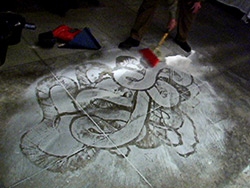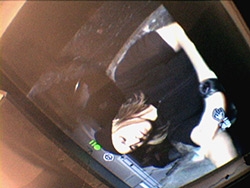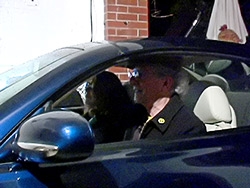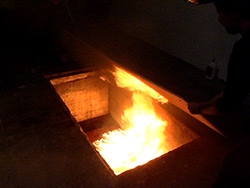Feature: Reviews
100 Performances for the Hole: The Garage Biennial
- San Francisco
The evening of January 26 capped a day of viewing engaging exhibitions in San Francisco. Among them was Paul Kos’s dynamic mini-retrospective, West of the Great Divide: 1968-2008 at Gallery Paule Anglim, and a survey of Katherine Westerhout’s rich pigment prints from her series Detroit at Electric Works. While these two gallery shows deserve and have received positive attention in the art press, I was engaged in a more unusual way during the one and one-half hours I spent experiencing 100 Performances for the Hole, Justin Hoover’s latest ambitious project for his curatorial venture, The Garage Biennial.
Consistent with his methodology, Hoover sent out an RFP to his email list, inviting proposals for two-minute performances in, around, responding to, or inspired by the mechanic’s pit in the gallery space he has used for several years to host The Garage Biennial — which is actually his family’s home garage. The project did not sound compelling when I first learned of it, but as the week preceding this event unfolded, a definite energy was in the air. The list of participating artists Hoover sent out also had some surprises. Though largely populated by San Francisco Art Institute-affiliated students, some well-known artists from the local community were also on the list, among them Gigi Janchang, Tom Marioni, and Sharon Grace. (Side note: Justin Hoover is currently a student in one of my graduate seminars at the San Francisco Art Institute).
The structure for the event was ambitious, and I spent some time betting with others just how long the hundred two-minute performances would REALLY take. Our quick calculation of how many minutes one hundred two-minute performances would actually take, three-plus hours, promised a long evening. The usual four hour Garage Biennial openings — planned to last from 6-10 pm — generally end well after midnight. During the time I attended this event, artists #37-50 performed their “two minute” pieces, so you do the math. As promised, this was an ambitious undertaking — a marathon exercise in performance art, at least for its curator.
The performances themselves ran a gamut, from the San Francisco Ballet School’s “Fun in the Sun,” which featured a group of several young women and men in bathing suits, pretending that the Hole was a body of water they were testing for swimming, and eventually ended up jumping into. The delightful flirting with one another and campy enactment of this summer ritual was well-complemented by a lively musical soundtrack. The piece had interesting affinities with one of Janet Cardiff and George Bures Miller’s installations, part of their exhibition The Killing Machine and Other Stories, 1995-2007, which I experienced last summer at the Institut Mathildenhöhe, in Darmstadt, Germany. By contrast, in a subsequent piece, artist Jennifer Locke bound her left arm with a rubber tourniquet, prepared a hypodermic needle, drew the blood from one arm and injected it into the other arm. This somewhat shocking process made a number of audience members (including me) cringe, and brought to mind some of Chris Burden’s early endurance art works like Shoot and Transfixed. A sense of Marcel Marceau-style comic relief was afforded by Emmanuelle Namont Kouznetsov’s work that followed. Dressed in a smart black dress and raincoat, Kouznetsov surprised the audience by slowly opening her coat to reveal such materials as garden tools and a bag of earth which were neatly attached to its lining. She used these items to prepare a small bed of earth in which she planted a flower on the Garage floor.
Projects of varying intensity and interest ensued, including several where the artist/performers created shadow theatre by covering the Hole with canvas, lighting it from below, and performing in the enclosed space. Though such a performance could be very successful in a solo situation, within the two minute/100 performer parameters of the evening, such pieces were effectively lost. By contrast, Tyler Borenstein was unflinchingly direct. He came to the edge of the hole, sat down and put out the invitation to anyone who wished, to come share a kiss with him. During a short interlude, various sorts of negotiation between couples and friends took place (fascinating to watch the gesticulations that were clearly of the “you go, no you do it” variety, or some couples that became tense in their interactions). Eventually, individuals people came forward, one by one, for their kiss—a young man in a fur coat; some women who seemed happy to just come to the artist and receive their kiss; a few men; a woman with a dog, both of whom received their kiss on the lips. The unmitigated willingness of this artist to sit still and kiss whoever chose to come forward—woman, man, animal—brought to mind Yoko Ono’s Cut Piece, making me briefly wonder what might happen if this were a twenty-minute or two-hour performance, rather than “two minutes.”
Though I missed a great number of the evening’s performances, the buzz about some of them that took place early in the evening—such as Tom Marioni and Sharon Grace’s slow drive through the Garage in a Lexus convertible (the Garage has two points of entry/egress), which included a stop inside just long enough to lower the car’s top, allow good jazz music to fill the space, and depart—definitely created a lively aura to the event, despite the return of pouring rain. This act of nature made watching the performances a more complicated process of simultaneously finding a decent sight line and shelter. I stayed through performance #50, Tom Borden’s extremely well-orchestrated performance, for which he produced a rustic wood box, from which he took a candle in a jar and a marshmallow, and set them on either side of the Hole. Borden then put on a tool belt, lit the candle, picked up the box and threw it into the hole, breaking it into pieces. This unexpected process of deconstruction was followed by the artist performing an incredibly fast, Chaplinesque re-making of the box with his drill and nails, followed by Borden’s then picking up the marshmallow he roasted over his burning candle, and eating it. Not exactly a two-minute performance, but nonetheless, amusing.
Although I can only speculate about the remaining fifty performances (the project ended somewhere during the wee hours of the morning), my experience of Hoover’s interpretation of what is possible within the construct of artist-run spaces at this point in time pays tribute—whether intentional or serendipitously—to the kinds of performance events Tom Marioni created for his MOCA space during the 1970s. In particular, 100 Performances for the Hole brings to mind Marioni’s All Night Sculpture, 1973, along with related projects by other artists that have taken place—and continue to—over the last 30-plus years. Aside from the enjoyment this event provided for those in attendance, the evening was a strong reminder that the unorthodox, underground art scene is alive and well in San Francisco.




